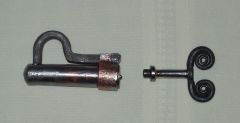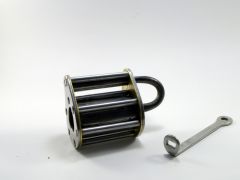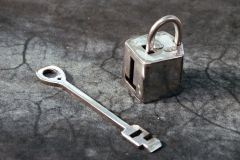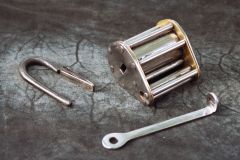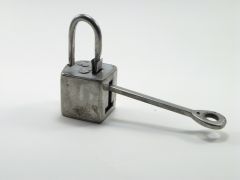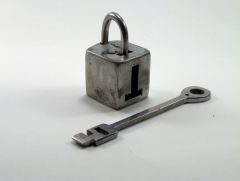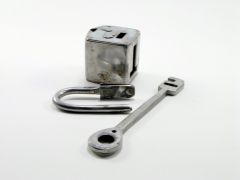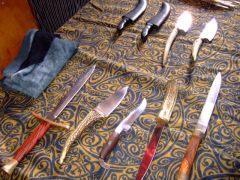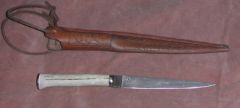-
Posts
26 -
Joined
-
Last visited
Contact Methods
-
Website URL
http://www.thornforge.orconhosting.net.nz
Converted
-
Location
Canterbury, New Zealand
-
Occupation
bladesmith
-
-
I have made in the past a couple large machettes, which I based on an old 'Celtic' boar hunting sword (it too had a tip the thickness of the spine). I'll try and dig up the info on the original. I did not have any material to make a swage out of, so I started with narrow stock the thickness I wanted the spine, and simply hung the back of the blade off the back/edge of the anvil and worked the rest out thinner. Hope that makes sense. Careful hammer blows were a must, and time had to be taken to correct any warpage as I went. But it did work and in essence was the same as forging any other blade. Heat treating T-backed blades can be a bit of an adventure too, due to the different thicknesses and the fact that (using this method) the thinner part has much more stresses in it due to working. Normalising to destress is imperative. The good part is that a differential heat treat is almost automatic with T-backs. Good luck
-
You must remember too, that the anvil is the biggest heat-sink you will find. It just loves to soak up all that heat you've just put into your stock. If you follow th above advice about practicing some general shaping you may find it is good to do this for a quater hour or so and then get your thinner stock (blade) in the heat. The practice stock will have warmed your anvil face a bit and therefore your blade wont cool *quite* as quickly.
-
LOL Good idea, shoulda thought of that myself.
-
Hey Mike. I presume you are talking of plantation pine, ?? Or at best what is called here abouts 'Old Man Pine', the stuff in the firewood pile. Leave it there, it is where it belongs. You will find even the old northern hemisphere standby's such as oak and the fruitwoods are not so suitable when grown in NZ, especially on the west coast, as they grow way to fast and are hence quite soft. NZ natives are some of the hardest and more spectacular woods around, and have much novelty value due to there not being much knowledge about them amongst the knifemakers of the world. As you are on the Wet Coast, you are in the heart of South Island native wood country, so you should have no trouble finding something. Kauri is alright, but not much figure (stripey contrast). Kahikatea is native 'white pine', again good, but not the best. Both can be found as demo wood from OLD buildings. Although most demo wood in your area will be Red Beech (great figure), totara or Rata, which just happens to be somewhere in the top 5 hardest woods of the world. It is quite oily and takes a wicked polish, though has almost no figure at all. The joy of demo wood is that it has been cured for up to 150 years, can't get much better than that. Otherwise try Rewarewa, spectacular; Pepper tree, amazing colours; Manuka, tight grained, highly figured and you are surrounded by it; Black Maire (from the Nth Is) etc. Yes, google it for some pics. Here is a place to start Bushmans Friend: New Zealand Native Plants & Nature Walks - Photos Native Tree Wood & Timber - Photos, New Zealand, native,plants,native ... Alot of these are perfectly allowable to cut, but NOT in the state forest. Find a local cocky with a stand of natives and go round with a 6 pack.
-
Ok, this one is a bit from left field, but it arose from bladesmithing so I thought I would ask it here. I recently completed a set of sample knives for a lady who wants a set of steak knives, but wasn't sure exactly what she wanted. All good. Got them made and polished up nicely, then took them round to show her. Usual story, oohs and ahhs, handmade knives, recycled materials, native wood handles, blah blah blah. Then she picked one up and 'huffed' on it. That is she breathed on it and watched it for a bit. This she repeated several times, each time watching intently. When I could contain my curiosity no longer, I asked what she was doing. Her reply was that she had been told that she could tell the 'quality' of the steel by how long the condensation took to disappear. ???!!!??? Now this sounds like a bunch of poppycock to me, but what do I know, I'm only a bladesmith . To me steel quality is rated in Carbon content, alloying metals, but mainly in good heat treating. Has anyone heard of this before?? I could see it as a test of body vs. ambient room temperature, or at best the degree of polish, but steel quality?? Over to you.
-
Cheers guys. My Web address is currently: Thornforge home The knives are a little out of date, I have many more recent pictures stored in dead computers, wish I could hit 'em with my hammer and make 'em work. It's still getting debugged, and will be moved soon to a server without banner ads, so please excuse the odd unsightly banner or other hiccup. Please let me know of any tho, then they can be added to the to-do list.
-
Hey everyone New member from New Zealand. I learned a lot about blacksmithing in my first fulltime job, which was in a commercial blacksmiths. Lots of drop-forging, big presses, and endless linishing. Been bladesmithing on and off for the past 5 years, just going full time at the moment. Recently have started producing medieval padlocks, which are real cool, and fun to make. My gallery has pics of the first three, there will be more.
-
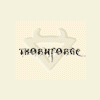
Medieval Padlock Reproductions
Images added to a gallery album owned by thornforge in Members Gallery
-

